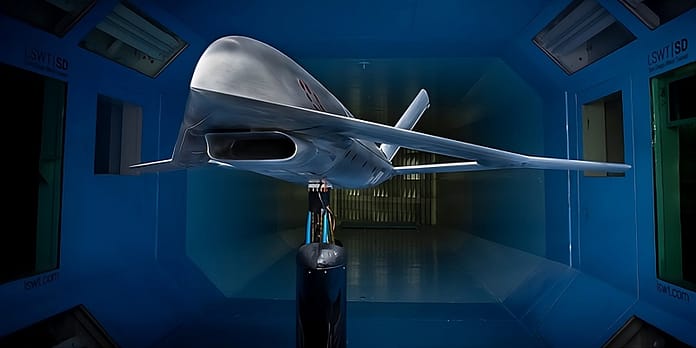- Aurora Flight Sciences, a Boeing subsidiary, got DARPA approval to produce the X-65, an experimental unmanned aircraft highlighting advancements in active flow control (AFC) technology for potential use in future aircraft designs.
- The X-65 in DARPA’s CRANE program aims to replace traditional moving parts with AFC effectors, boosting aircraft performance through reduced weight, drag, and mechanical complexity. Its modular design enables versatile testing.
- The X-65 will undergo 2025 testing to assess AFC technology viability, marking a major advance in aircraft design for military and commercial aviation.
Aurora Flight Sciences, a subsidiary of Boeing, is collaborating with the Defense Advanced Research Projects Agency (DARPA) on an innovative project. Together, they are working on the X-65, an experimental unmanned aircraft within DARPA’s Control of Revolutionary Aircraft with Novel Effectors (CRANE) program. The goal is to transform aircraft design using active flow control (AFC) technology, which eliminates conventional moving parts such as flaps and rudders. The X-65 aims to challenge conventional flight norms and potentially reshape the future of both military and commercial aircraft. Let’s now explore the details of this ambitious venture.
Table of Contents
The X-65 and AFC Technology
The X-65, designed under the CRANE program, is a unique unmanned aircraft that adopts a sleek, aerodynamic structure with AFC effectors strategically placed across its flying surfaces. These effectors play a pivotal role in controlling the X-65’s roll, pitch, and yaw by manipulating bursts of air, eliminating the need for external moving parts. DARPA envisions that this departure from conventional designs could lead to significant performance enhancements in future aircraft, reducing weight, drag, and mechanical complexity.
Critical Design Review and Manufacturing Commencement
Aurora Flight Sciences recently attained a crucial milestone by completing the critical design review, signaling the green light from DARPA to commence the manufacturing of a full-scale X-65 model. The success of this review underscores the viability and progress of the AFC technology. As the manufacturing phase unfolds, the aerospace community eagerly anticipates the X-65’s first flight, scheduled for the summer of 2025.

AFC’s Potential Impact on Aircraft Design
By incorporating AFC technology, the X-65 aims to pave the way for a new era in aircraft design. The AFC effectors on the X-65’s surfaces are poised to offer insights into maneuverability, efficiency, and performance in real-world tests. DARPA emphasizes the potential advantages of AFC, such as weight reduction, increased stealth due to its diamond X-shape, and streamlined aerodynamics. The X-65’s modular design allows for the testing of various AFC configurations, presenting a platform for ongoing experimentation beyond the CRANE program.
Collaborative Efforts: Aurora Flight Sciences and DARPA
Aurora Flight Sciences, in collaboration with Lockheed Martin, initially joined the CRANE program in 2021, securing a role in the preliminary design phase. Subsequently, Aurora emerged as the sole contractor for phase 2, clinching a $42 million deal in 2023 for detailed design work, flight software development, and controls. This collaboration highlights the commitment of both entities to advancing aerospace technology through innovative solutions.
X-65 Specifications and Testing Approach
According to DARPA’s specifications, the full-scale X-65, constructed in phase 3, will weigh over 7,000 pounds, boast a 30-foot wingspan, and achieve speeds up to Mach 0.7. The X-65’s testing strategy involves a combination of conventional moving control surfaces and AFC effectors. The initial tests will use traditional surfaces as a baseline, gradually transitioning to exclusive AFC effector control. This phased approach allows for a comprehensive understanding of AFC’s performance compared to traditional control mechanisms.
The X-65’s Modular Future
The X-65’s modular design is a key feature that extends its utility beyond the CRANE program. With easily replaceable outboard wings and AFC effectors, the X-65 can accommodate diverse AFC designs for future testing. This adaptability ensures the aircraft’s relevance as a long-term test asset for DARPA and other agencies, fostering continued exploration of AFC applications in both military and commercial aviation.
The Impact of AFC on Future Aircraft
As the X-65 moves closer to its anticipated first flight in 2025, the aerospace community eagerly awaits the insights it will provide into the potential of AFC technology. The data gathered during the X-65’s tests will inform future aircraft design considerations, offering a glimpse into a world where active flow control replaces traditional flight control surfaces. If successful, this revolutionary approach could redefine the possibilities for high-performance, efficient, and stealthy aircraft in the years to come.
Beyond X-65: DARPA’s SPRINT Program
While the X-65 is breaking new ground in AFC technology, DARPA continues to push the boundaries with its Speed and Runway Independent Technologies (SPRINT) program. Collaborating with companies like Aurora Flight Sciences, DARPA aims to design experimental vertical takeoff-and-landing aircraft capable of surpassing the speed of existing models like the V-22 Osprey. This initiative reflects DARPA’s commitment to exploring innovative concepts that could revolutionize how aircraft operate in areas lacking traditional runways.
Conclusion
The collaboration between Aurora Flight Sciences and DARPA on the X-65 project exemplifies a bold step towards transforming the landscape of aircraft design. The integration of AFC technology opens doors to enhanced performance, reduced complexity, and potentially groundbreaking advancements in both military and commercial aviation. As the X-65 progresses toward its first flight, the aerospace industry eagerly anticipates the revelations that could shape the future of flight control systems. Beyond the X-65, DARPA’s SPRINT program adds another layer of innovation, signaling a commitment to exploring novel concepts that could redefine the capabilities of vertical takeoff and landing aircraft. The journey into this new era of flight promises to be both groundbreaking and transformative.

